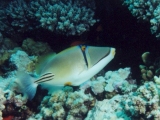Tuesday, July 21, 2009
Fish surveys could be inaccurate
 Fish surveys are often conducted by SCUBA divers or snorkellers. A study in the journal Environmental monitoring and assessment has found that these surveys may be inherently inaccurate as snorkellers frighten away the fish they are supposed to be counting.
Fish surveys are often conducted by SCUBA divers or snorkellers. A study in the journal Environmental monitoring and assessment has found that these surveys may be inherently inaccurate as snorkellers frighten away the fish they are supposed to be counting.Researchers from at the University of Victoria, Canada, used an underwater video camera to assess how fish abundance, family richness and community composition were affected by snorkellers and divers on a coral reef in Thailand. They found that snorkellers significantly disturbed the fish they were supposed to be recording. The SCUBA divers didn't provoke the same disturbance. However, only 6 divers were involved in the study so the results are not conclusive.
The researchers suggest that the use of a stationary video camera may help cross-check data that is collected by divers and snorkellers to assess the true family composition and document the presence of rare and easily disturbed species.
Journal Reference:
Environ Monit Assess. 2009 Apr 8
What do you think of this news item? Join a discussion.
Labels: environment, research, SCUBA diving, SCUBA News
Wednesday, July 15, 2009
Creature of the Month: Dragonet, Callionymus lyra

One hundred and eighty-six species of the "Little Dragon" fish live from Iceland in the North to the Indo-Pacific oceans in the South. You will find the species we are concentrating on today, Callionymus lyra, from Norway to Senegal: in the Eastern Atlantic and the North, Irish, Mediterranean, Black, Baltic, Aegean and other Seas.
The adult male C. lyra is colourfully patterned in orange and blue. The females are smaller and a mottled brown. They have an interesting courtship ritual. The male performs an elaborate display, darting around the female, spreading his brightly coloured fins and pulling faces! If the female is impressed the pair then swim side-by-side, almost vertically up to the surface. There they release the eggs and sperm into the water, spawning at dusk. Dragonet males are thought to mate only once in a lifetime.
Dragonets spend most of their lives on sandy or rocky bottoms. They live from the shallows down to 100 m. They are sometimes confused with gobies but have a much broader triangular, head and a long dorsal ray on their backs. If you see slender fish meeting this description darting away from you on the bottom it is probably a dragonet.
Further Reading:
Great British Marine Animals, by Paul Naylor
Labels: fish, marine biology, SCUBA diving, SCUBA News, SCUBA Travel, UK
Thursday, July 02, 2009
Belize barrier reef in Danger
The reef was added as a world heritage site in 1996 as the largest barrier reef in the northern hemisphere, with offshore atolls, several hundred sand cays, mangrove forests, coastal lagoons and estuaries.
The main problem with Belize Barrier Reef Reserve System concerns mangrove cutting and excessive development. The reef is also the country’s top tourist destination.
While requesting stricter control of development on the site, the World Heritage Committee also requested that the moratorium on mangrove cutting on the site which expired in 2008 be reinstated.
Further Reading:
List of World Heritage in Danger
What do you think of this news item? Join a discussion.
Labels: Belize, coral reef, SCUBA diving, SCUBA News, SCUBA Travel